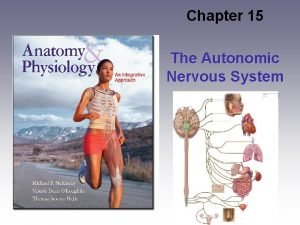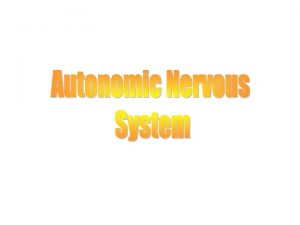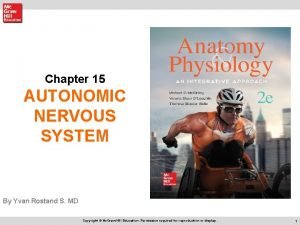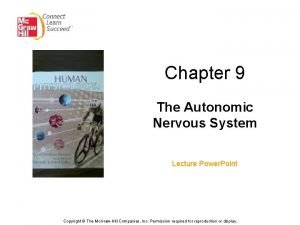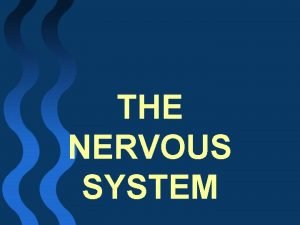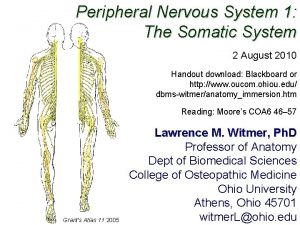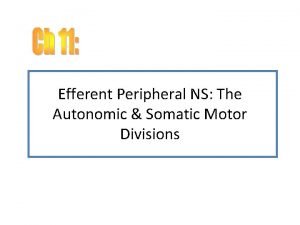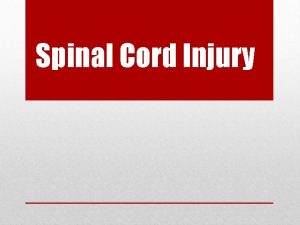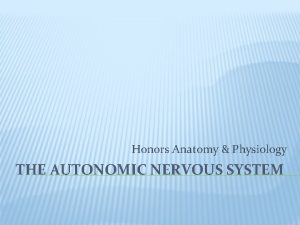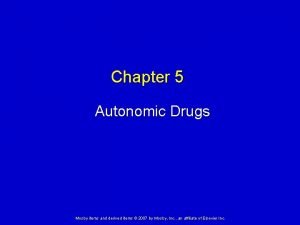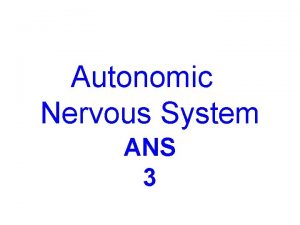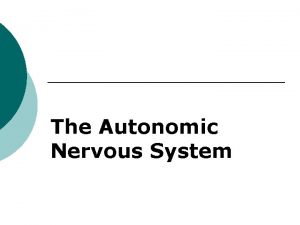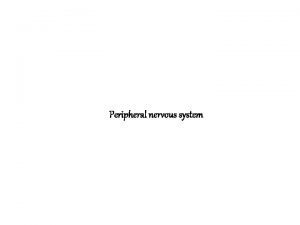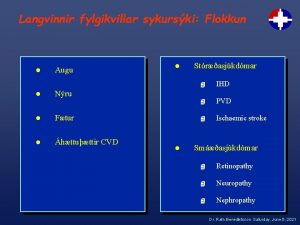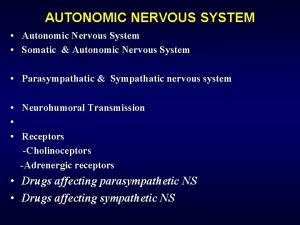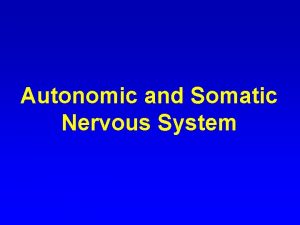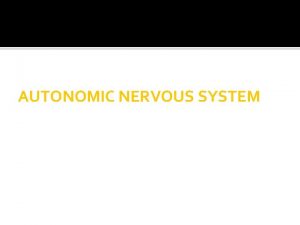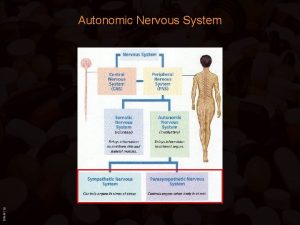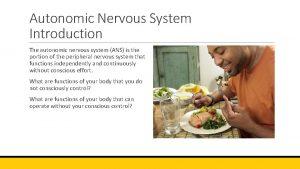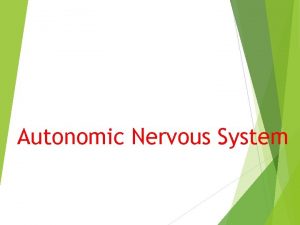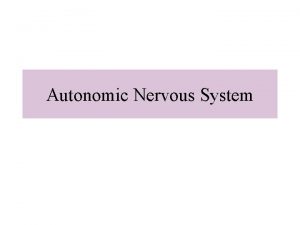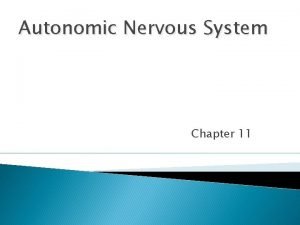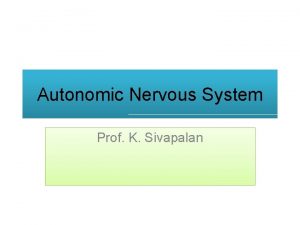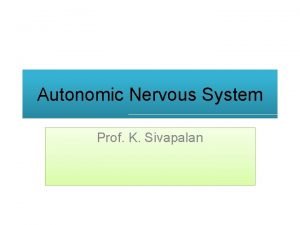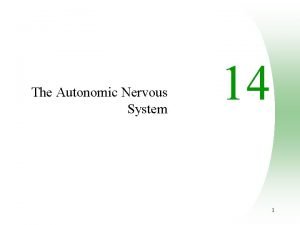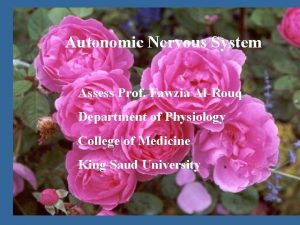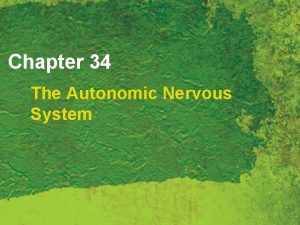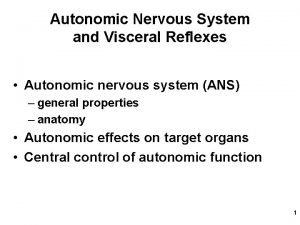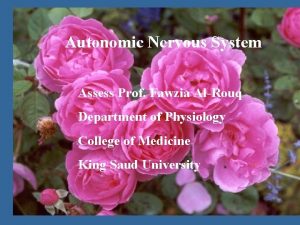Physiology of autonomic nervous system Comparison of Somatic







































- Slides: 39

Physiology of autonomic nervous system

Comparison of Somatic and Autonomic Nervous System Somatic Autonomic n Smooth and cardiac muscle n Skeletal muscle and glands n Conscious and n Unconscious regulation unconscious movement n Skeletal muscle contracts n Target tissues stimulated or n One synapse inhibited n Two synapses n Acetylcholine n Acetycholine by preganglionic neurons and ACh or norepinephrine by postganglionic neurons


n Autonomic nervous system n Chain of two motor neurons n n n Preganglionic neuron Postganglionic neuron Conduction is slower due to thinly or unmyelinated axons Pre-ganglionic Post-ganglionic Ganglion

Comparison of ANS & PNS n. Compare the one motor neuron of the somatic motor division with the two neuron chain of the autonomic nervous system Figure 15. 2

Somatic and Autonomic Nervous System

Divisions of ANS n There are two division of the ANS n n n Parasympathetic Sympathetic Metasympathetic Generally the two divisions have chains of two motor neurons that innervate same visceral organs but cause essentially opposite effects If one division stimulates certain smooth muscle to contract or a gland to secrete, the other division inhibits that action Through this process of duel innervation the two systems counterbalance each other

Divisions of ANS n n n Both the sympathetic and parasympathetic divisions issue from the brain and spinal cord Two neuron pathways are shown for both divisions Solid lines indicate pre -ganglionic axons while broken lines indicate postganglionic axons

Where they come from Parasympathetic: craniosacral Sympathetic: thoracolumbar

Sympathetic ACh Nicotine Tyramine, Ephedrine amphetamine + N NE + αβ

Divisions of the Autonomic Nervous System Sympathetic – “fight, flight, or fright” n Activated during exercise, excitement, and emergencies n Parasympathetic – “rest and digest” n Concerned with conserving energy n

Functions of the Autonomic Nervous System n Sympathetic activities n “E situations” n Exercise n Emergency n Excitement n Embarrassment

Functions of the Autonomic Nervous System n Parasympathetic activities n n Stimulated by: n Quiet periods n Paradoxical fear SLUDD Produces “rest-and-digest” response n Supports body functions that conserve and restore body energy n Reduce body functions that support physical activity

Function of the Sympathetic Nerve n Sympathetic nervous system prototypically “fight” or “flight”. n Associated with increased Ø energy expenditure, Ø Ø cardiopulmonary adjustments for intense activity, blood flow adjustments for maximum energy expenditure.

SNS - Fight & Flight Reaction You’re walking alone at night and all the sudden you hear an unfamiliar noise near by… In a matter of seconds, Ø your heart rate increases dramatically, Ø blood vessels in your skeletal muscles dilate, Ø blood vessels in the visceral muscles constrict, Ø digestion is ceased, Ø your liver ramps up glucose release, Ø your pupils dilate, Ø salivary production decreases, Ø sweat increases.


Sympathetic Preganglionic cell bodies in lateral horns of spinal cord T 1 -L 2


Sympathetic Trunk Ganglia Located on both sides of the vertebral column n Linked by short nerves into sympathetic trunks n Joined to ventral rami by white and gray rami communicantes n Fusion of ganglia fewer ganglia than spinal nerves n

Sympathetic Pathways to Periphery Figure 15. 9

Sympathetic Pathways to the Head Figure 15. 10

Sympathetic Pathways to Thoracic Organs Figure 15. 11

Parasympathetic Nervous System If that noise turns out to be the result of wind, then the body is returned to “pre-noise” state. n This is the job of the parasympathetic nervous system. n

Autonomic Nervous System • Parasympathicus • Sympathicus • Wind down, relaxation, digestion • Dominated by Acetylcholine • Fight & Flight Reaction • Dominated by Noradrenaline (Adrenaline) • Fear, exercise, rage

Different Lengths of their Fibers n Sympathetic is the opposite with short preganglionic and long postganglionic fibers Parasympathetic division has long preganglionic and short postganglionic fibers

Anatomical Differences in Sympathetic and Parasympathetic Divisions Figure 15. 4 a

Divisions of ANS n Therefore, all sympathetic ganglia lie near the spinal cord and vertebral column, and all parasympathetic ganglia lie far from the CNS, in or near the organs innervated

Parasympathetic

Parasympathetic Division n The parasympathetic division is most effective in non-stressful situations This division is chiefly concerned with keeping body energy use as low as possible, even as it directs body processes such as digestion and elimination Resting and digesting division


Parasympathetic ACh Nicotine Black widow Spider venom + N ACh + M

Parasympathetic Nervous System: Sacral Outflow Emerges from S 2 -S 4 n Innervates organs of the pelvis and lower abdomen n Preganglionic cell bodies n Located in visceral motor region of spinal gray matter n Form splanchnic nerves n

Sacral Outflow n n The sacral outflow arises from neurons located in the lateral horn of the spinal cord at S 2 - S 4 The axons of these neurons run in the ventral roots of the spinal nerves to the ventral rami

Sacral Outflow n n From the ventral rami the neurons branch to form the pelvic splanchnic nerves Most neurons synapse in the intramural ganglia located in the walls of the distal large intestine, urinary bladder and reproductive organs

Neurotransmitters and Neuroreceptors n Acetylcholine and Norepinephrine n All preganglionic neurons are cholinergic n n n Parasympathetic post ganglionic neurons are cholinergic Sympathetic post ganglionic neurons are adrenergic except Sympathetics innervating sweat glands, blood vessels in skeletal muscle, and piloerection muscles are cholinergic

Cholinergic Receptors The two types of receptors that bind ACh are nicotinic and muscarinic n These are named after drugs that bind to them and mimic ACh effects n

Acetylcholine n n Nicotinic receptors n Nm (muscular-type or N 2): skeletal muscle n Nn (neuron-type, or N 1): autonomic ganglia, CNS Muscarinic receptors n Postganglionic parasympathetic and a few sympathetic sites, CNS (also autonomic gang. ) n Receptor subtypes: M 1 -5


n Thank you!
 Somatic vs autonomic nervous system
Somatic vs autonomic nervous system Major division and parts of the nervous system
Major division and parts of the nervous system Somatic and autonomic nervous system
Somatic and autonomic nervous system Sympathetic nervous system def
Sympathetic nervous system def Autonomic nervous system consists of
Autonomic nervous system consists of Autonomic
Autonomic Autonomic nervous system
Autonomic nervous system The autonomic nervous system controls
The autonomic nervous system controls Parasympathetic and sympathetic
Parasympathetic and sympathetic Autonomic dysreflexia
Autonomic dysreflexia Terminal ganglia
Terminal ganglia Somatic nervous system (sns)
Somatic nervous system (sns) Somatic nervous system
Somatic nervous system Neurotransmitter of somatic nervous system
Neurotransmitter of somatic nervous system Somatic nervous system
Somatic nervous system Nerves
Nerves Brain and spinal cord nervous system
Brain and spinal cord nervous system Somatic motor neuron
Somatic motor neuron Fundamentals of the nervous system and nervous tissue
Fundamentals of the nervous system and nervous tissue Nervous
Nervous Neuronal processes
Neuronal processes Comparison of endocrine and nervous system
Comparison of endocrine and nervous system Exocrine glands are ductless
Exocrine glands are ductless Autonomic nerveous system
Autonomic nerveous system Nervous system and digestive system
Nervous system and digestive system Endocrine system and nervous system
Endocrine system and nervous system Mechanism of action of hormones
Mechanism of action of hormones Adh function
Adh function Comparison convergence test
Comparison convergence test Autonomous vs automatic bladder
Autonomous vs automatic bladder Ans
Ans Autonomic network management
Autonomic network management An architectural blueprint for autonomic computing
An architectural blueprint for autonomic computing Mosby items and derived items
Mosby items and derived items Autonomic drugs
Autonomic drugs The vision of autonomic computing
The vision of autonomic computing Visceral reflex arc in order
Visceral reflex arc in order Autonomic state
Autonomic state Autonomic computing ibm
Autonomic computing ibm Diabetic autonomic neuropathy
Diabetic autonomic neuropathy






